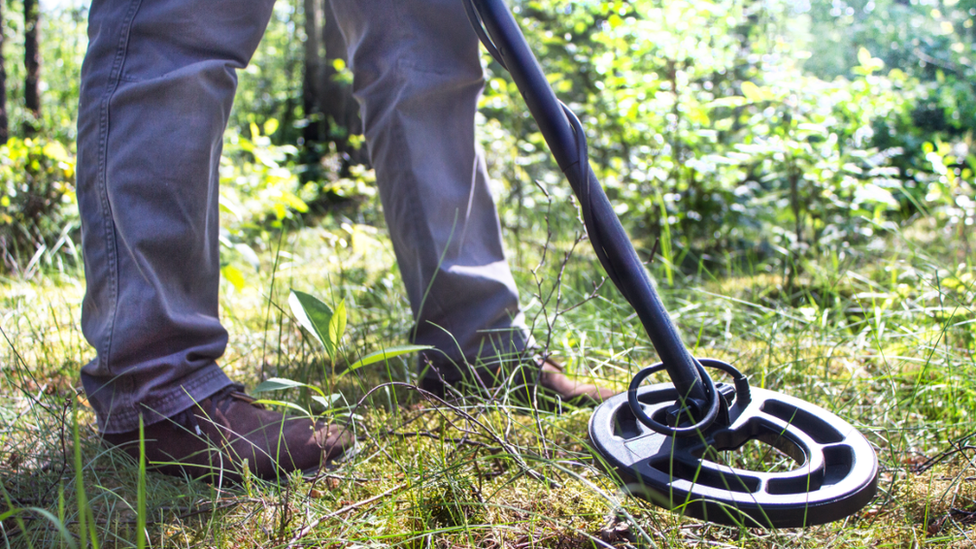Detectorists stole Viking hoard that 'rewrites history'
- Published
The history stolen by metal detectorists
Two metal detectorists stole a £3m Viking hoard that experts say has the potential to "rewrite history".
George Powell and Layton Davies dug up about 300 coins in a field in Eye, near Leominster, Herefordshire, in 2015.
They did not declare the 1,100-year-old find, said to be one of the biggest to date, and instead sold it to dealers.
They were convicted of theft and concealing their find. Coin sellers Simon Wicks and Paul Wells were also convicted on the concealment charge.
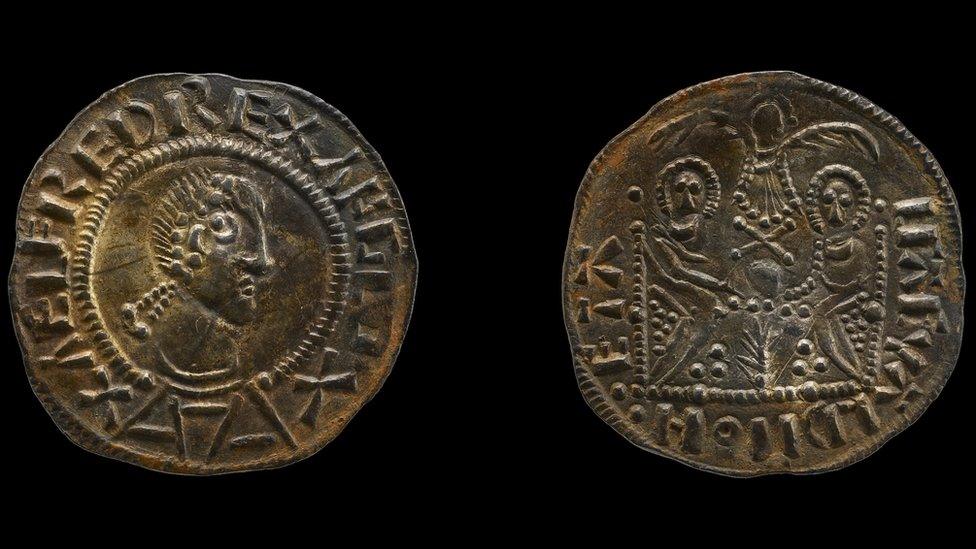
Most of the estimated 300 coins believed to be in the hoard are still missing
The hoard included a 9th Century gold ring, a dragon's head bracelet, a silver ingot and a crystal rock pendant. Just 31 coins - worth between £10,000 and £50,000 - and some pieces of jewellery have been recovered, but the majority is still missing.
"They must be concealed in one or more places or by now having been concealed have been dispersed never to be reassembled as a hoard of such coinage again," prosecutor, Kevin Hegarty QC, said.
During their trial at Worcester Crown Court, Powell, 38, of Newport, and Davies, 51, of Pontypridd, had denied deliberately ignoring the Treasure Act, which demands significant finds be declared.
Experts say the coins, which are Saxon and believed to have been hidden by a Viking, provide fresh information about the unification of England and show there was an alliance previously not thought to exist between the kings of Mercia and Wessex.
"These coins enable us to re-interpret our history at a key moment in the creation of England as a single kingdom," according to Gareth Williams, curator of early medieval coins at the British Museum.

Layton Davies, George Powell, Paul Wells and Simon Wicks were convicted by a jury at Worcester Crown Court
When Powell and Davies made their discovery in June 2015, they did not inform the farmer who owned the field and instead contacted dealers to find out the worth of the items.
A month later, they contacted the National Museum of Wales but only declared one coin each and three items of jewellery.
Both men claimed talk of a 300-coin hoard had been a rumour, but suspicions were aroused and police began to investigate. They recovered deleted photos on Davies's phone which showed the hoard intact in a freshly dug hole.
The court heard the detectorists had been meeting Wicks, from Hailsham, and Wells, from Cardiff, to release the coins on to the market.
Wicks, Powell and Davies were also found guilty of converting the stolen hoard into cash after police traced several coins which had been sold to private collectors.
Wells told the court he knew the coins should be declared, but was himself found to have hidden five in a magnifying glass handle.

What is the significance of the hoard?
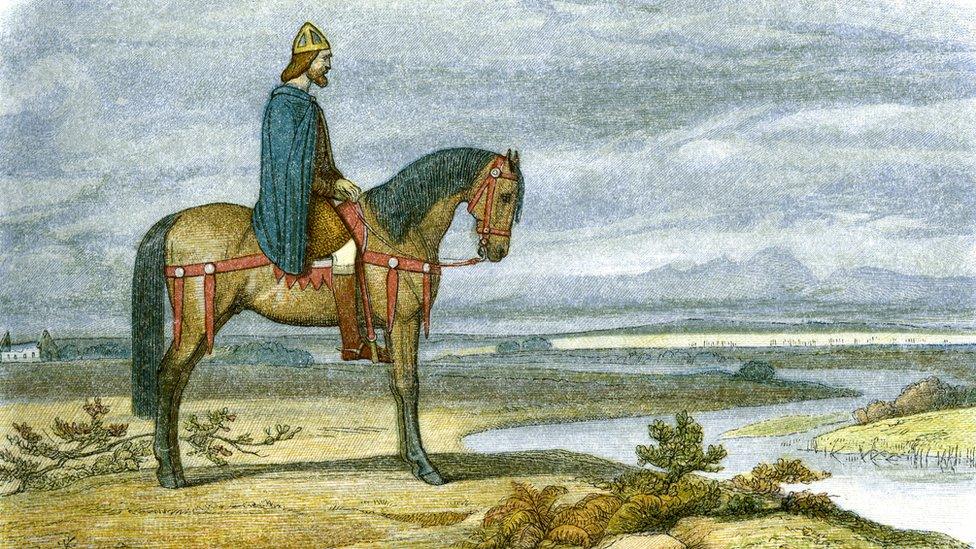
Alfred the Great is the most famous Anglo Saxon king and ruled Wessex from 871 to 899
The recovered coins were issued by two separate, but neighbouring, kingdoms in the late 9th Century: Wessex and Mercia.
Wessex at the time was ruled by the famous Alfred the Great and Mercia by the lesser known Ceolwulf II, who "just disappears from history without a trace" when the hoard was buried around the year 879, Mr Williams said.
"What the coins show, beyond any possible doubt, is that there was actually an alliance between Alfred and Ceolwulf," Mr Williams continued, as they were sharing a coin design.
"And yet a few years later, Ceolwulf is dismissed by historians at Alfred's court. He's written out of history, but the coins show a different picture.
"This is a find of national importance from a key moment in the unification of England.
"It comes just at the moment when the Vikings were attacking in a large way."

Peter Reavill, the finds liaison officer for the British Museum in Shropshire and Herefordshire, said it was a concern hobbyists like Powell and Davies could prioritise personal financial gain over national interests.
"It will be so easy for really important objects just to slip through the net, mostly due to individuals' greed.
"Important information has been lost forever. That's our heritage, everyone's heritage, that's being lost in the hope of financial gain and I think that's terrible," Mr Williams added.
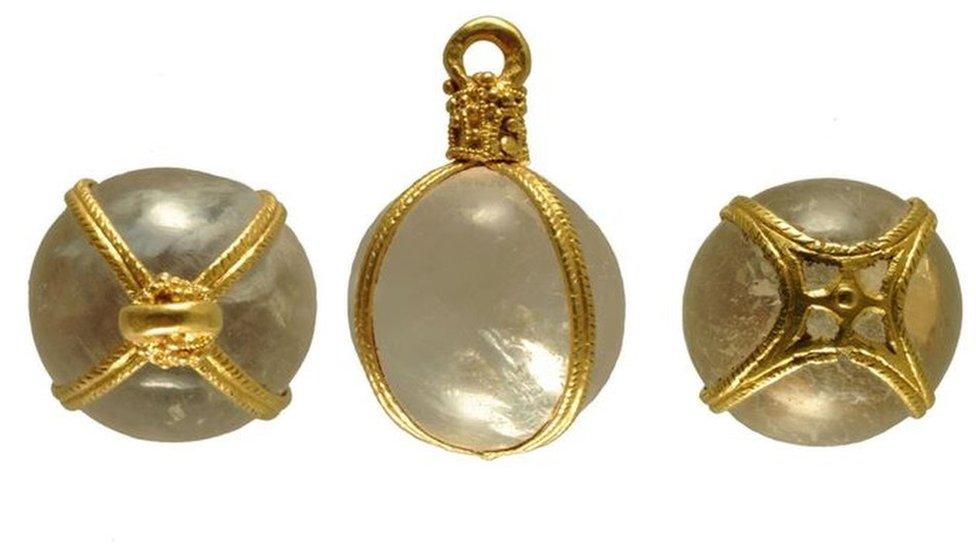
Among the hoard was a crystal pendant that dates to around AD600

Who buried the hoard and why?
Although most of the hoard is Anglo Saxon, Mr Williams has no doubt it was gathered and buried by a Viking.
A Viking army is known to have been in the area at the time, he said, attacking the Wessex and Mercia kingdoms including the Battle of Edington, Wiltshire, in 878 against Alfred the Great, one year before the hoard is thought to have been buried.
"It was probably buried to preserve it from other Vikings as well as Anglo Saxons," Mr Williams said, "and for whatever reason the person who buried it wasn't able to go back and recover it".

Amanda Blakeman, West Mercia Police's Deputy Chief Constable, said the men were looking to "criminally profit from removing the historical footprint of our country".
"It's absolutely critical that we protect our heritage, our history, and we bring offenders to justice who are looking to profit from something that is owned by the community," she said.
Ms Blakeman has recently been appointed as the national leader for heritage and cultural crime and has established police and expert networks to help tackle these "complex and protracted" investigations in the future.
"We must recover that property and we must cut off those markets that are available to be able to disperse our history, not only across this country, but across the world," she said.
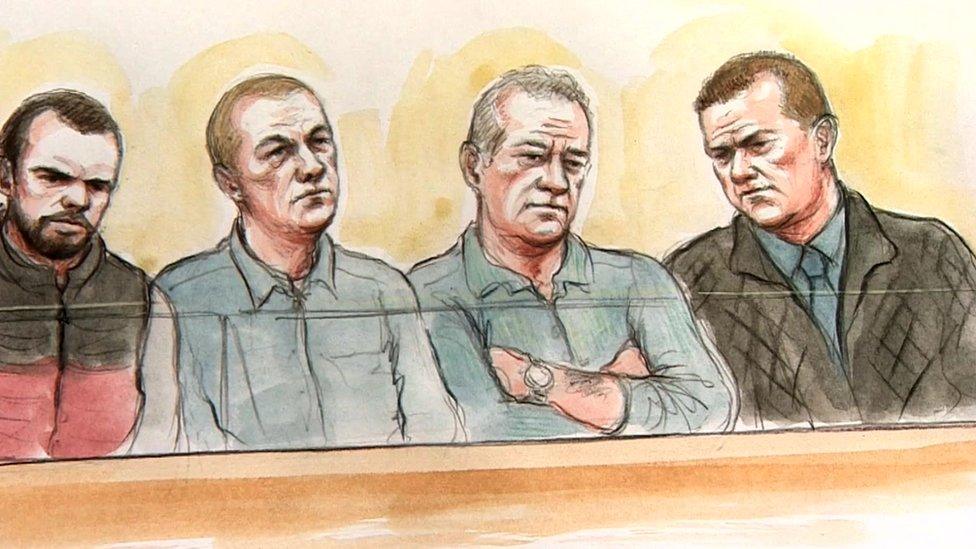
All four men were convicted of ignoring the law which states significant finds must be declared
As the verdicts were read out, an ambulance was called for Wells who became unwell.
Court was adjourned until Friday for sentencing and the other defendants were remanded in custody.
Judge Nicholas Cartwright said: "I am not going to admit George Powell bail, he's going to be sentenced for theft of items worth millions of pounds and is facing a very long sentence of imprisonment and in addition to that there will inevitably be a confiscation process.
"There are hidden assets by way of unrecovered treasure worth a very large sum, probably millions of pounds, so there's the prospect of a very long default period of imprisonment should the assets remain hidden."

Follow BBC West Midlands on Facebook, external, on Twitter, external, and sign up for local news updates direct to your phone, external.
Related topics
- Published21 November 2019

- Published28 October 2019
